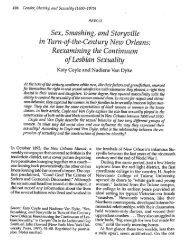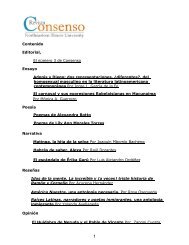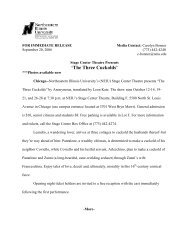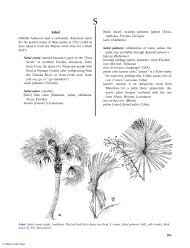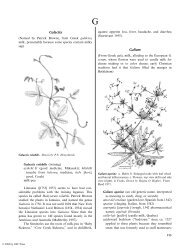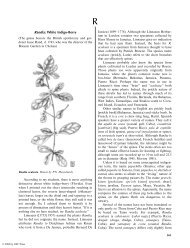Herba Cana - Northeastern Illinois University
Herba Cana - Northeastern Illinois University
Herba Cana - Northeastern Illinois University
Create successful ePaper yourself
Turn your PDF publications into a flip-book with our unique Google optimized e-Paper software.
© 2004 by CRC Press<br />
532 Florida Ethnobotany<br />
1st century A.D. selecting samples. Bending over, he<br />
gently snaps off the stems, and thinks that the bitter<br />
plants will produce polygalon (much milk). They will<br />
be useful to the farmer who had recently come to him<br />
for help renewing the flow of milk in his cow.<br />
Dioscorides tucks the plants gingerly into a small<br />
bag he has draped over his shoulder and walks on.<br />
Speakers of different Mediterranean languages<br />
called these plants their linguistic equivalents of<br />
milkwort (wort, plant) long before the Dutch herbalist<br />
Rembert Dodoens published the Latin name in 1554.<br />
Henry Lyte’s translation of Dodoens’s Dutch text on<br />
Polygala says that it ‘‘engendreth plentie of milk;<br />
therefore it is good to be used of nurses that lack<br />
milk.’’ Others following this idea include Italian<br />
poligala, Spanish hierba lechera (milk giving herb),<br />
Portuguese erva leiteira, and French latier (milk giver).<br />
Gaels also call them lus a’bhainne (milk herbs). In<br />
spite of these names and beliefs, there is no experimental<br />
evidence that the plant extracts increase milk<br />
flow.<br />
Europeans know the plants by other names.<br />
Norwegians call them bla˚fjaer (blue-flower). While<br />
not all their species have blue flowers, they retain the<br />
basic name and add modifiers, such as bitterbla˚fjaer<br />
(P. amarella) orstorrbla˚fjaer (storr, big, P. vulgaris).<br />
In Guernsey Polygala is herbe de paralysie, and it is<br />
used to treat or prevent paralysis or strokes. Gaelic<br />
speakers in Scotland call the herb saibann nam bansidh<br />
(fairy women’s soap). Indeed, many species<br />
contain saponins (soaplike compounds). The Germans<br />
call it Kreuzblume (cross-flower). One can see a<br />
resemblance (with considerable imagination) to a cross<br />
in the flowers.<br />
Many of the Florida species have common names<br />
that reflect their colorful flowers. Bachelor’s buttons,<br />
the least creative among these, was adopted from<br />
unrelated European plants (Centaurea cyanus, Asteraceae).<br />
Sometimes that name is applied to all the<br />
species, but there are more often modifiers, as in white<br />
bachelor’s-button (P. balduinii), bog bachelor’s-button<br />
(P. lutea), dwarf bachelor’s-button (P. nana), and<br />
yellow bachelor’s-button (P. rugelii).<br />
Some of the more intriguing common names for<br />
milkworts are given to P. cruciata (drum-heads) and P.<br />
pauciflora (gay-wings, bird on the wing, baby’s toes,<br />
baby’s feet, baby’s slippers, satin flower, Indian pink,<br />
maywing). However, the most curious names for<br />
Florida’s P. incarnata are procession-flower or Rogation-flower,<br />
both of which it shares with European P.<br />
vulgaris. <strong>Herba</strong>list John Gerarde in 1597 explained<br />
these names by saying that the plants ‘‘flourish in the<br />
Crosse or Gang weeke, or Rogation weeke; of which<br />
floures the maidens which use in the countries to walk<br />
the Procession doe make themselves garlands and<br />
nosegaies, in English we may call it Crosse-floure,<br />
Rogation floure, and Milkewort, of their virtues in<br />
procuring milk in the breasts of nurses.’’ Rogation<br />
Sunday is the fifth Sunday after Easter, and it is<br />
followed by Rogation Week when church processions<br />
(or ‘‘gangs’’), led by a person carrying a cross, bless<br />
crops. This may be another pagan ritual incorporated<br />
into the Christian religion, because there is a word in<br />
Gaelic for the procession*/liodan.<br />
Milkworts, also known as candyweeds or candyroots<br />
(because of a licorice taste to the roots of some),<br />
are small herbs in North America and northern<br />
Europe, but in drier climates and within the tropics<br />
they may be shrubs or even trees (Mabberley 1997).<br />
Some species produce dyes, and one from tropical<br />
Africa (P. butyracea) yields a fiber.<br />
Many species around the world are used in<br />
medicines, although only one in North America has<br />
received much publicity. That northern species, P.<br />
seneca (snake-root, Seneca snakeroot), became famous<br />
as a snakebite remedy when the first Europeans<br />
arrived in the New World. Although its effectiveness in<br />
treating snakebite is doubtful, the species became<br />
popular for treating pleurisy, the most common<br />
ailment in colonial Virginia (Coffey 1993). Even<br />
William Byrd (1674 /1744), one of the surveyors of<br />
the line between North Carolina and Virginia, used it<br />
to treat gout in a member of his party in early 1728<br />
(Byrd [1728] 1980).<br />
Snake-root contains the glucoside senegin (a<br />
saponin), polygalic acid, resin, methyl salicylate, and<br />
fatty oils (Hocking 1997). Several of these make the<br />
plant potentially effective in medicines as an emetic,<br />
expectorant, cathartic, diuretic, antispasmodic, and<br />
sweat inducer, to regulate menses, for colds, and<br />
against croup, pleurisy, rheumatism, heart troubles,<br />
convulsions, and coughs, and as a poultice against<br />
swelling. The presence of methyl salicylate also supports<br />
its use against some of these maladies. This<br />
chemical is more familiar under the name of ‘‘wintergreen’’<br />
and it has long been used in medicine and<br />
flavorings. Florida’s P. boykinii shares methyl salicylate<br />
with others, and has been used in Mexico in a cold<br />
water infusion to correct dizziness (Hocking 1997).<br />
Similarly, Seminoles told Sheehan in 1919 that it was a<br />
medicine for treating vertigo (von Reis and Lipp<br />
1982).<br />
Pollen of the genus has been found in the pre-<br />
Columbian deposits at the Glades site of Fort Center<br />
on the western side of Lake Okeechobee (Hogan<br />
1978). The Seminoles have different names for P.<br />
rugelii and related species, but they seem to use each<br />
one as a generic term for several species. The species<br />
has had religious significance in Florida for a long<br />
time, and this relationship is indicated by the Micco-





